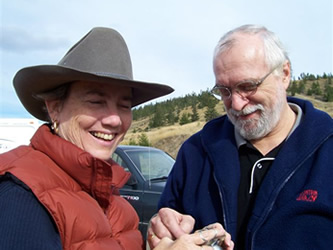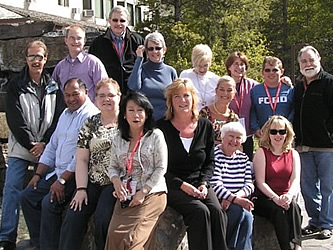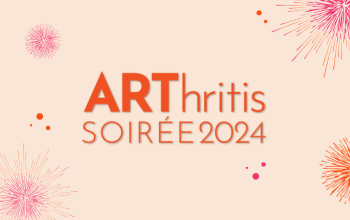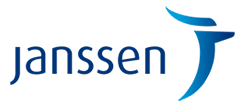The Arthritis Newsletter
Fall 2011Make Volunteering Work For You!
 People volunteer for a number of different reasons, and volunteers come from diverse employment backgrounds. When people leave their jobs through retirement or disability, volunteerism can provide a place where they can use the specific skills and talents they have developed in the paid workplace.
People volunteer for a number of different reasons, and volunteers come from diverse employment backgrounds. When people leave their jobs through retirement or disability, volunteerism can provide a place where they can use the specific skills and talents they have developed in the paid workplace.
Pam Montie was a successful businesswoman when rheumatoid arthritis came into her life, making it impossible for her to continue working. Transitioning from a computer system analyst to business owner was easy for her; but the transition from the business world to the unknown world of arthritis was unsettling, to say the least.
When a successful treatment plan finally allowed Pam to resume working, she decided to dedicate her time to arthritis awareness. Having lived with the pain and disability of arthritis, she recognized that people with arthritis didn’t always have the necessary knowledge to manage their disease. It also became apparent to her that the general public was not aware of the impact arthritis can have on one’s life. In 2002 armed with a passion for the cause, she joined The Arthritis Research Centre of Canada (ARC) as a member of the Consumer Advisory Board (CAB).
Over the past nine years, she has contributed extensively to ARC’s mission and has found her perspective, a patient’s perspective, welcomed and valued. She has come to realize that volunteering is not just an altruistic act; in fact, she feels she has benefited in many ways. It has been an opportunity to learn more about the cause she supports, build self-confidence, enlarge her social network, and gain extensive knowledge about her condition – knowledge she communicates to the arthritis community through education sessions.
 As a result of her association with CAB, Pam has joined both national and international arthritis groups. One group, OMERACT (Outcome Measures in Rheumatology) holds conferences every 2 years in various parts of the world. Patients have been actively engaged in the process since 2002, and Pam has attended OMERACT conferences in California, Malta, Alberta, and Borneo. For those not familiar with OMERACT’s initiative, Pam co-authored a consumer-friendly article, which posed the following questions:
As a result of her association with CAB, Pam has joined both national and international arthritis groups. One group, OMERACT (Outcome Measures in Rheumatology) holds conferences every 2 years in various parts of the world. Patients have been actively engaged in the process since 2002, and Pam has attended OMERACT conferences in California, Malta, Alberta, and Borneo. For those not familiar with OMERACT’s initiative, Pam co-authored a consumer-friendly article, which posed the following questions:
… What is the best way to measure whether a treatment works or not? What are the best outcomes to measure in research studies? Improvement is usually measured using various scales and questionnaires. But what should the scales and questionnaires measure? Pain? Function? Stiffness? Joint tenderness? Fatigue? …
It would be great if researchers could measure everything. But with limited funds and sometimes questionnaires that aren’t very good, it’s important to select what outcomes are valuable to measure and the best questionnaires to do that. Selecting the most important outcomes is turning out to be difficult though – researchers, clinicians, patients, statisticians and questionnaire developers have different ideas about what is most important.
For this reason, OMERACT was started in 1992. OMERACT is an international conference held every two years in which people come together to share research, debate and decide what outcomes should be used in rheumatology research. While at the conference, attendees make plans for more research into the development of new scales and questionnaires and the validation of scales that already exist. i …
Joining group discussions at OMERACT conferences came easily to Pam; she was accustomed to communicating with researchers. In her own words, “CAB brought me to the research table, exposing me to the researchers and their dialogue. The researchers taught me that my opinion mattered and that sharing my experiences of living with rheumatoid arthritis is important.” Her involvement with OMERACT has further increased her sense of purpose, as she believes she is directly contributing to the research agenda.
… the OMERACT research agenda has been enriched by the identification of new domains that are relevant from a patient perspective. The most important example has been the increased efforts to gain more knowledge about the nature and impact of fatigue in rheumatoid arthritis. Fatigue has been added to the rheumatoid arthritis core-set and is now widely measured as an important outcome in clinical trials.ii …
 In May, Pam attended the annual congress of the European League Against Rheumatism, EULAR 2011 in London, England. This congress provided an opportunity for over 16,000 participants (professionals involved in rheumatology as well as consumers) to present and discover the latest developments in the field of rheumatology. She was a member of the OMERACT consumer group that gave an oral presentation at this conference: Patient Research Partners Shaping Participatory Research to Define Rheumatoid Arthritis Flare: Lessons Learned to Guide Patient Involvement.
In May, Pam attended the annual congress of the European League Against Rheumatism, EULAR 2011 in London, England. This congress provided an opportunity for over 16,000 participants (professionals involved in rheumatology as well as consumers) to present and discover the latest developments in the field of rheumatology. She was a member of the OMERACT consumer group that gave an oral presentation at this conference: Patient Research Partners Shaping Participatory Research to Define Rheumatoid Arthritis Flare: Lessons Learned to Guide Patient Involvement.
Pam is more involved than ever and continues to enjoy the significant role she has in arthritis research. Although rheumatoid arthritis was an unwelcome partner in Pam’s life many years ago, the outcome did not include the death of her talents. Instead, she is able to offer those talents and her experiences to organizations as a volunteer – which Pam can now take enormous pride!
Learn More:
OMERACT: www.omeract.org
EULAR: www.eular.org
_________________________________
i “OMERACT: Research, debate and outcomes“, CAPA Voices, Sep 2006.
iiIP106: A Decade of Patient Involvement in OMERACT: What Difference has it Made? Maarten de Wit and John Kirwan


























































